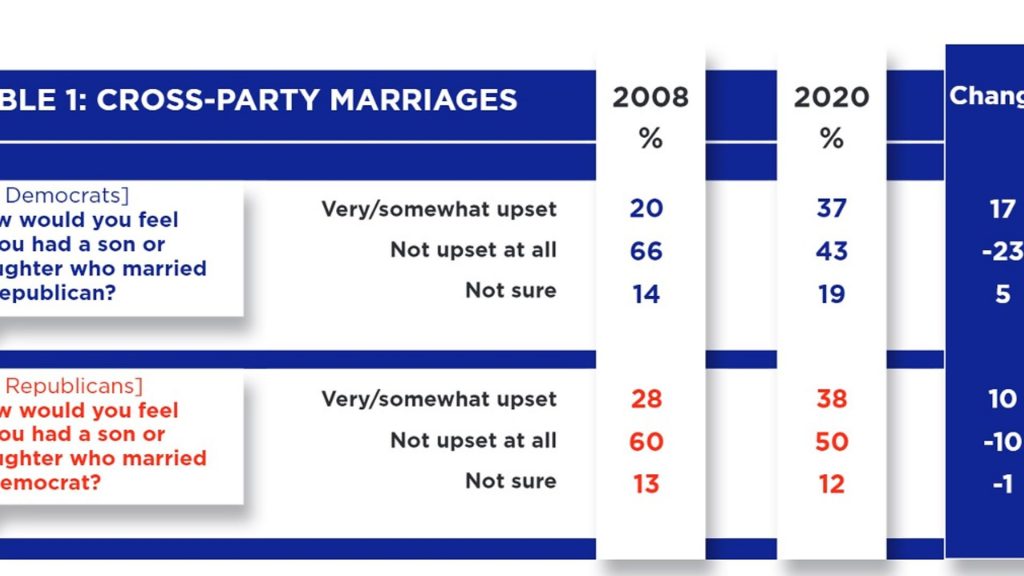
Never mind the polls in the race for the White House, a new survey shows a more complex picture of America’s deeper fault lines.
The bitter polarisation of the American election is only too obvious. For many of us, the contours of the battle are clear: in one corner, Joe Biden: a decent, moderate candidate with liberal values and respect for what science tells us about issues ranging from climate change to Covid-19. In the other corner, Donald Trump, aggressively anti-liberal, self-serving and alarmingly disrespectful of truth and science. It is only too easy to assume that their followers match the image of their candidate, with Democratic and Republican voters inhabiting difference universes of belief and outlook.
New research shows that the truth is more complex. Twelve years ago, during the run-up to Barack Obama’s first election as president, YouGov asked Americans about their basic beliefs. It has just repeated the same questions. The big picture is that the US electorate has become a little more liberal but a lot more polarised. But within that, millions of Americans defy the easy categories. Around 15 million Democrat voters are essentially conservative, while around 10 million Republicans veer towards a rational liberalism.
However, the biggest changes since 2008 reflect the polarisation not of values but of tribes. YouGov asked people how they would feel if their son or daughter married someone who identified with the opposite party.
As the table on this page shows, a minority feared a cross-party marriage 12 years ago, but clear majorities were relaxed about the prospect. Today, hostility to the idea is much greater, especially among Democrats. In 2008, for every one who said they would be upset, more than three said they wouldn’t mind. Today, the two groups are running almost level. Tens of millions of Democrats seem to be saying: a Trump supporter in the family? No way.
Republicans have shifted less, but still by a fair amount, from 2-1 saying not upset, to 4-3. So polarisation is increasing on both sides; but Trump seems to have shifted the dial among Democrats more than Biden has among Republicans. Whoever wins next month’s election, the polarisation not just of America’s politicians but big sections of its electorate will cast a shadow that may take years to disperse.
That said, there is better news for those of us who find many of the tenets of America’s Republican right illiberal and irrational. YouGov repeated six questions that divide liberal and conservative sentiment in the US. Respondents were asked to choose between rival statements.
There is a lot to unpack in the results – which omit don’t knows and, in some cases, compromise options – so let’s take it step-by-step.

First, there has been a clear but modest shift since 2008 towards a more liberal outlook. On all six issues, fewer people hold conservative views and more people hold liberal views. In the country as a whole, the average figure for conservative views is down from 38% to 32%, while the average for liberal views is up from 35% to 39%. In terms of this particular set of averages, the three-point ‘lead’ for conservatism 12 years ago has turned into a seven-point lead for liberalism today.
Second, Republicans have become significantly less conservative. Twelve years ago, an average of 58% gave conservative responses to the six questions. That figure is down 10 points to 48% today. The shift should not be overstated: most Republicans still reject the notion of man-made climate change, regard gay sex as a sin and want to outlaw all or most abortions. But in each case, the minorities who oppose these views have risen sharply.
Third, America’s Democrats are more liberal than they were – but, in some important respects, they are still not that liberal. Big majorities of Democrats think abortions should generally be legal, and that climate change is a real, and man-made, problem. But on four of the six issues, around one in four Democrats still hold conservative views: on evolution, abortion, gay sex and sex outside marriage.
Although this research shows what has happened in the past 12 years, it reflects an extension of longer trends: a very gradual decline in conservative values; a growing tribal divide between Democrats and Republicans; but, within each party a continuing variety in social attitudes that we do not see when we look only at the activists in both parties.
In terms of election results, the tribal divide is the most obvious. Between 1952 and 1984, voters’ loyalties were far more fluid than they are today. Five of the nine presidential elections were won with double-digit percentage leads in the popular vote. Support for the candidates of the two main parties oscillated between more than 60% and less than 40%. But in the eight elections between 1988 and 2016, the sizes of the rival tribes have varied far less; there have been no double-digit victories. The biggest winning margin in that time was Bill Clinton, who defeated Bob Dole in 2004 by 8.5%.
Current polls suggest that Joe Biden might achieve a double-digit victory next month in the popular vote. If he does, it will be a remarkable achievement by the standards of the past three decades.
That is unlikely, however, to prevent the US Supreme Court having a 6-3 conservative majority. Two of the big issues it is likely to face concern abortion and health care. On abortion, YouGov’s figures show that liberals now slightly outnumber conservatives. However, most ‘conservatives’ reject the purist view that abortion should never be allowed. Such purists comprise just 13% of all Americans, while 33% dislike abortion in general, but agree it should be legal “in special circumstances such as when the life of the mother is in danger”.
This helps to explain why a recent poll for NBC finds that by 66-27%, Americans don’t want the Supreme Court to overturn its 1973 Roe v Wade decision that women have a constitutional right to an abortion during the first three months in pregnancy. The fight to overturn Roe v Wade has been led by purists: they don’t have the electorate with them. Caution extends to many Republicans: they divide evenly between keeping and overturning Roe v Wade.
On health care, figures are not available from 2008, as Obamacare had not yet been designed. But, again, the polls confirm the shift towards a more progressive outlook. The latest poll for Fox News finds that 64% want to keep Obamacare, while 32% want to replace it. At the height of the Clinton-Trump battle four years ago, the same pollsters found that just 41% wanted to keep Obamacare while 52% wanted to replace it.
All in all, the long-term social trends in American society are good for progressives, even if the pace of change is not as fast as many would like. However, given America’s constitution, and in particular the make-up of the Supreme Court, even a big win for Biden may not give them all they want, at least not yet.

YouGov questioned 1,000 Americans between March 7 and 11, 2008, and put the same questions to 1,500 Americans between September 13 and 15, 2020.
Fieldwork was conducted online, and the raw data weighted to the profile of all adult American citizens
Warning: Illegal string offset 'link_id' in /mnt/storage/stage/www/wp-includes/bookmark.php on line 357
Notice: Trying to get property 'link_id' of non-object in /mnt/storage/stage/www/wp-includes/bookmark.php on line 37






